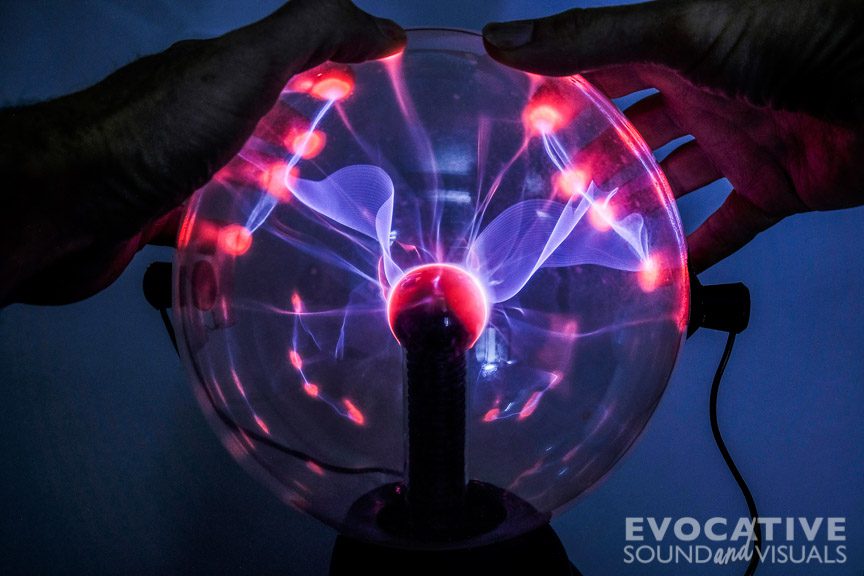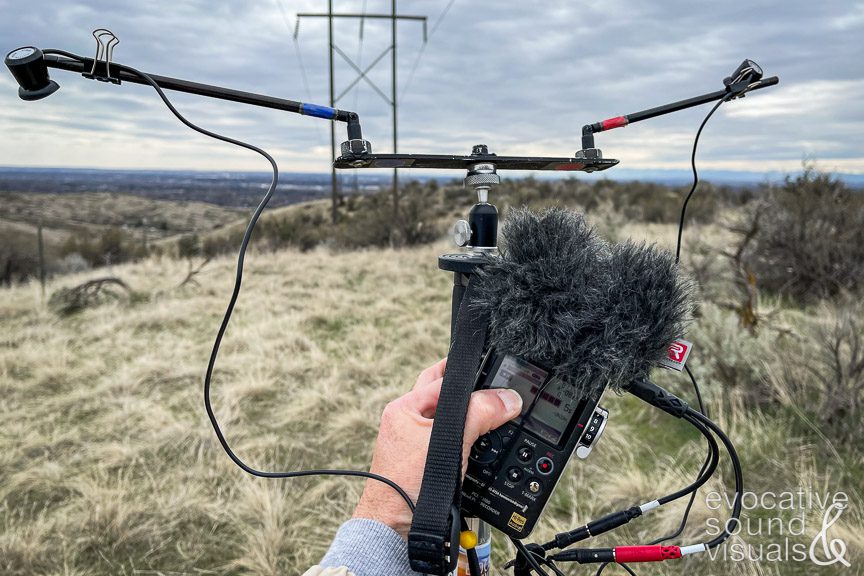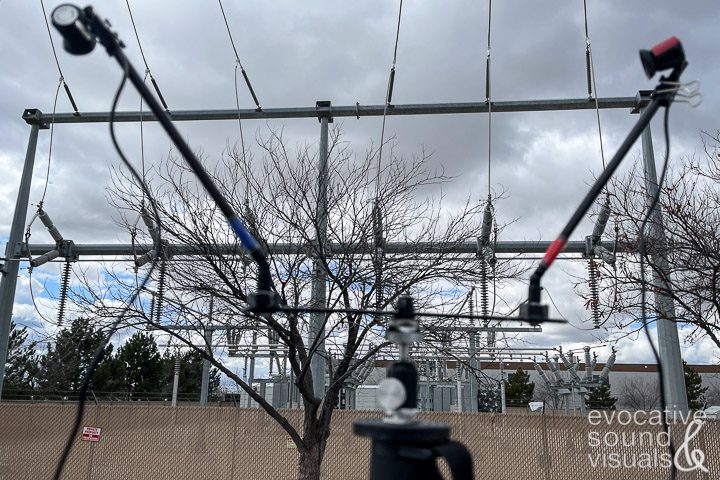Evocative Sound and Visuals is pleased to announce the release of Electromagnetic Fields. This library contains 163 meticulously crafted and mastered sounds from 68 devices and structures captured in high-quality stereo with a Sony PCM D100 recorder and two small induction coil microphones. Included are hums, drones, beeps, bleeps, buzzes, glitches, pulses, static and more strange sounds I cannot describe.

With few exceptions, we mere mortals can’t hear the electromagnetic fields (EMF) surrounding us. If we could, we’d most certainly go crazy, especially in our ever-expanding electronic environment. Using induction coil microphones, we can tune our ears into this other sonic world.
I never knew quite what to expect when placing mics on an object. Having two microphones with fairly long cables allowed me to find the most sonically interesting parts of an object to focus on. Two mics spaced apart also allow for a nice stereo spread.
Have fun experimenting with and inserting these hi-tech sounds (some captured in 96kHz/24-bit and others in 192kHz/24-bit) into your next science fiction and otherworldly creations. Please don’t take the device’s sound literally. That SLR motor drive may be your next out-of-this-world rapid-fire laser cannon.
Listen to a Preview
Library Specifics
- Captured with Sony PCM D100 and Sony PCM M10 recorders pair with two induction coil microphones (some at 96kHz/24-bit and others at 192/24kHz/24-bit)
- 163 sounds
- 6.73 GB
- UCS compliant
- metadata included (Soundly and BWF)
Devices Recorded for This Library
- battery charger
- Blu-ray player
- board game
- calculator
- camera flash (studio and on-camera)
- point and shoot cameras (4)
- SLR camera
- cd player
- smartphone and charger
- computer (desktop and laptop)
- external hard drive
- flatbed scanner
- printer
- dog nail file
- Rotary die grinder tool
- drill
- electric shaver
- electronic reader
- face cleansing brush
- battery-powered fan
- flashlight
- hair dryer
- hand blender
- hand sander
- handheld game console
- laser pointer
- LED flicker lights
- LED light strings
- LED closet lights
- LED mirror
- LED therapy light
- microwave oven
- milk frother
- nose trimmers (3)
- overhead power lines (6)
- paper shredder
- plasma ball
- pulse oxygen meter
- hand crank radio
- transistor radio
- handheld and boombox cassette recorders
- digital recorders
- sound level meter
- spark timer accelerator
- TENS unit
- toothbrush
- typewriter
- vacuum
- vehicle
- walkie talkie
- washing machine
- wristwatch
How I Made Electromagnetic Fields
Like many of you, I’ve listened to EMF sounds from computers, routers, smartphones and televisions. They always sound awesome, and I’ve recorded some here. But I wanted more. To do this, I literally started at the source.
Recording Overhead Power Lines
If you’re young enough or your ears are good enough, you may hear the buzz coming off high-voltage overhead power lines. While the towers holding them all resemble an extra-angry Looney Toons Tasmanian Devil, the lines don’t all sound alike. Contrary to what you may think, a 138 KV line sounds different from a 345 KV line. I’ve noticed sounds from a line can change during a recording session. Humidity, wind and moisture all play a part in these slight fluctuations. This high-intensity buzz becomes the sonic building block for everything else in the library.
Recording Battery Versus A/C Gadgets
For battery-operated devices, to avoid the 60-cycle mains hum in my home, I’d drive over to a local park and find a bench. In winter, I’d sit in the car with the engine off. By the way, my 2016 Subaru gives off an EMF too, and it’s included. For A/C powered devices, I was tied to the cord at the house. I found the device always overpowered the hum of the room.
LED lighting was one of the most interesting EMF sounds I captured. These battery-powered lights look innocent enough, but when you turn them on and attach induction coil mics they sound fascinating. Watch these three examples below. An LED bathroom mirror that to me gives off a sound straight out of a horror movie. A pulsating battery-powered holiday flicker light string and a battery-powered closet light.
How You Can Discover This Unheard World
For those coming to this post with a background in audio field recording and sound design, you are probably knowledgeable of what electromagnetic fields are and how recording their sounds can enhance your sound design. For the uninitiated, let me briefly explain what EMF is and how I record them.
Non-ionizing electromagnetic radiation has occurred naturally since the dawn of time. When the needle on your granddad’s green army compass points north, it’s because of the earth’s magnetic field. If you’ve ever witnessed the aurora borealis in all its colorful glory, thank the earth’s magnetic field once again. I finally experienced the Northern Lights recently. Take a look.
To record EMF sounds, induction coil microphones, or ‘telephone pickups,’ are used. These are nothing more than a small coil of copper wire wrapped around a tiny iron bar. They detect the changes in electromagnetic fields surrounding them and convert them into electric signals that recorders can recognize. The tiny pickups beneath electric guitar strings utilize this principle. So did the HO model train from my youth and the giant generators inside hydroelectric dams.
The mics I used for Electromagnetic Fields came from the age of rotary telephones. If you wanted to record a telephone conversation on the cheap, covertly or otherwise, placing one of these suction cup devices on the backend of a telephone’s handset (the receiver not the microphone) was one of the simplest ways. They are still available online. Get yourself a pair.
Non-Ionizing Versus Ionizing EMF
What’s the difference between non-ionizing and ionizing EMF? Ionizing EMF comes from ultraviolet (UV), x-rays and gamma rays. These are high up there on the electromagnetic spectrum. I did not go there. I searched out and recorded non-ionizing EMF. This informative and colorful illustration by the National Cancer Institute shows where various electromagnetic fields lies on the lie on the electromagnetic spectrum.





